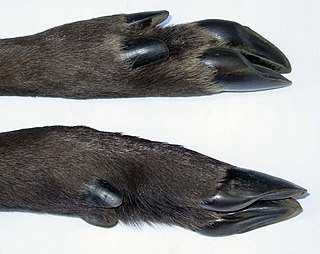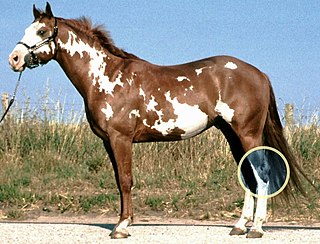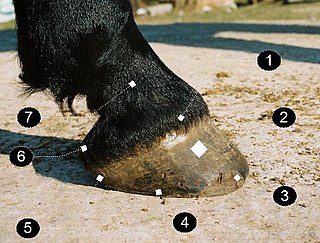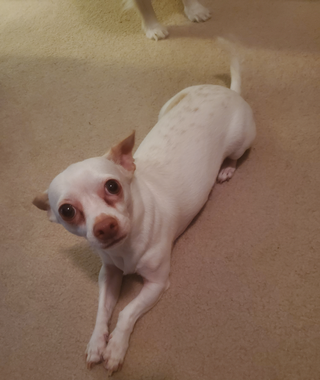
Cow-hocked (adj.) or cow hocks (n.) describes a defect in the conformation of four-legged animals, primarily of livestock and horses, but also of dogs and cats.

Cow-hocked (adj.) or cow hocks (n.) describes a defect in the conformation of four-legged animals, primarily of livestock and horses, but also of dogs and cats.

An animal is cow-hocked when its hock is set inward, resulting in a splayed look in the back legs. This can result in the uneven wearing of hooves, which can end up in permanent lameness, and can prove to be a very serious condition. Permanent lameness usually results in the animal going for meat, as the cow will be in far too much pain to move, the milk in a cow will not be up to standard, and the animal could not be used in breeding, as this trait would pass on. However, most animals will not have too serious a condition, and will walk with a splayed-leg look. Another way of spotting cow-hock is when the hooves point outward as a result of the incorrect lineup of the joints in the leg.
Another problem with cow-hocks is when the joints in the leg are not set correctly, the joints in the back will most likely be set incorrectly as well. The animal will not do well in agricultural shows, will be in a lot of pain, and for both of these reasons, it is advised to take the animal out of any breeding programs.
In cow-hocked horses, the hind hocks are too close together and point toward each other, with the feet too widely apart. It is a fairly common defect, and if the metatarsal bones are vertical, may not always cause lameness. A combination of cow- and sickle-hocks poses a greater risk. [1]
Cats are commonly cow-hocked, with the hind legs angling inward at the ankles and the feet splaying outward more than forward. Mild cow-hocking is negligible, and kittens often look a little cow-hocked, but if the defect is severe, the resulting poor alignment can damage the joints and spine. [2] A similar deviation may occur in the vertical alignment of a dog's rear structure. [3]

The Munchkin, also known as Sausage Cat is a breed of cat characterized by its very short legs, which are caused by genetic mutation. Compared to many other cat breeds, it is a relatively new breed, documented since 1940s and officially recognized in 1991. The Munchkin is considered to be the original breed of dwarf cat.

In dogs, hip dysplasia is an abnormal formation of the hip socket that, in its more severe form, can eventually cause lameness and arthritis of the joints. It is a genetic (polygenic) trait that is affected by environmental factors. It is common in many dog breeds, particularly the larger breeds, and is the most common single cause of arthritis of the hips.

The hoof is the tip of a toe of an ungulate mammal, which is covered and strengthened with a thick and horny keratin covering. Artiodactyls are even-toed ungulates, species whose feet have an even number of digits, yet the ruminants with two digits, are the most numerous, e.g. giraffe, deer, bison, cattle, goat, and sheep. The feet of perissodactyl mammals have an odd number of toes, e.g. the horse, the rhinoceros, and the tapir. Hooves are limb structures restricted to placental mammals, which have long pregnancies; however, the marsupial Chaeropus had hooves.

The piaffe is a dressage movement where the horse is in a highly collected and cadenced trot, in place or nearly in place. The center of gravity of the horse should be more towards the hind end, with the hindquarters slightly lowered and great bending of the joints in the hind legs. The front end of the horse is highly mobile, free, and light, with great flexion in the joints of the front legs, and the horse remains light in the hand. The horse should retain a clear and even rhythm, show great impulsion, and ideally should have a moment of suspension between the foot falls. As in all dressage, the horse should perform in a calm manner and remain on the bit with a round back.

The hock, or gambrel, is the joint between the tarsal bones and tibia of a digitigrade or unguligrade quadrupedal mammal, such as a horse, cat, or dog. This joint may include articulations between tarsal bones and the fibula in some species, while in others the fibula has been greatly reduced and is only found as a vestigial remnant fused to the distal portion of the tibia. It is the anatomical homologue of the ankle of the human foot. While homologous joints occur in other tetrapods, the term is generally restricted to mammals, particularly long-legged domesticated species.

Laminitis is a disease that affects the feet of ungulates and is found mostly in horses and cattle. Clinical signs include foot tenderness progressing to inability to walk, increased digital pulses, and increased temperature in the hooves. Severe cases with outwardly visible clinical signs are known by the colloquial term founder, and progression of the disease will lead to perforation of the coffin bone through the sole of the hoof or being unable to stand up, requiring euthanasia.
Bone spavin is a bony growth within the lower hock joint of horse or cattle. It is caused by osteoarthritis, and the degree of lameness that results can be serious enough to end a horse's competitive career.

Equine conformation evaluates a horse's bone structure, musculature, and its body proportions in relation to each other. Undesirable conformation can limit the ability to perform a specific task. Although there are several faults with universal disadvantages, a horse's conformation is usually judged by what its intended use may be. Thus "form to function" is one of the first set of traits considered in judging conformation. A horse with poor form for a Grand Prix show jumper could have excellent conformation for a World Champion cutting horse, or to be a champion draft horse. Every horse has good and bad points of its conformation and many horses excel even with conformation faults.
Splints is an ailment of the horse or pony, characterized by a hard, bony swelling, usually on the inside of a front leg, lying between the splint and cannon bone or on the splint bone itself. It may be "hot," meaning that it occurred recently and is still painful; or "cold," meaning that the splint has completely recovered and there is no longer any swelling or pain associated with it. Bucked shins are sometimes called 'shin splints,' which involve small stress fractures of the dorsal cannon bone, often seen in race training, and discussed elsewhere.

A stable bandage, or standing bandage/wrap, is a type of wrap used on the lower legs of a horse. A stable bandage runs from just below the knee or hock, to the bottom of the fetlock joint, and protects the cannon bone, tendons of the lower leg, and fetlock joint.

A horse hoof is the lower extremity of each leg of a horse, the part that makes contact with the ground and carries the weight of the animal. It is both hard and flexible. It is a complex structure surrounding the distal phalanx of the 3rd digit of each of the four limbs, which is covered by soft tissue and keratinised (cornified) matter.

Equine anatomy encompasses the gross and microscopic anatomy of horses, ponies and other equids, including donkeys, mules and zebras. While all anatomical features of equids are described in the same terms as for other animals by the International Committee on Veterinary Gross Anatomical Nomenclature in the book Nomina Anatomica Veterinaria, there are many horse-specific colloquial terms used by equestrians.
A sickle-hocked leg structure is one in which the back leg joints of an animal, usually a horse or other equine mammal, are set with too much angle, resulting in the hock also being excessively angled. This can result in uneven hoof wear, which is incredibly painful for the affected horse. If the leg joints are not set properly, there is a high chance that the back joints are also set incorrectly, resulting in a poorly conformed horse.
Post-legged describes a condition in which the joints in an animal are not set correctly. When an animal is post-legged, the leg joints are far too straight, with almost no bend in the legs. Four-legged animals must have some bend in the hocks, otherwise the hooves would wear unevenly, and this may result in lameness, or at least a rougher gait. The animal will not stand squarely on the ground, and this also increases the possibility of injury to the animal.
A flexion test is a preliminary veterinary procedure performed on a horse, generally during a prepurchase or a lameness exam. The purpose is to accentuate any pain that may be associated with a joint or soft-tissue structure, allowing the practitioner to localize a lameness to a specific area, or to alert a practitioner to the presence of sub-clinical disease that may be present during a pre-purchase exam.
Lameness is an abnormal gait or stance of an animal that is the result of dysfunction of the locomotor system. In the horse, it is most commonly caused by pain, but can be due to neurologic or mechanical dysfunction. Lameness is a common veterinary problem in racehorses, sport horses, and pleasure horses. It is one of the most costly health problems for the equine industry, both monetarily for the cost of diagnosis and treatment, and for the cost of time off resulting in loss-of-use.

Jumping plays a major role in many equestrian sports, such as show jumping, fox hunting, steeplechasing, and eventing. The biomechanics of jumping, the influence of the rider, and the heritability of jumping prowess have all been the focus of research.

Good conformation in the limbs leads to improved movement and decreased likelihood of injuries. Large differences in bone structure and size can be found in horses used for different activities, but correct conformation remains relatively similar across the spectrum. Structural defects, as well as other problems such as injuries and infections, can cause lameness, or movement at an abnormal gait. Injuries to and problems with horse legs can be relatively minor, such as stocking up, which causes swelling without lameness, or this and othat b of the hod a es quite serious. Even leg injuries that are not immediately fatal may still be life-threatening to horses, as their bodies are adapted to bear weight on all four legs and serious problems can result if this is not possible.
The treatment of equine lameness is a complex subject. Lameness in horses has a variety of causes, and treatment must be tailored to the type and degree of injury, as well as the financial capabilities of the owner. Treatment may be applied locally, systemically, or intralesionally, and the strategy for treatment may change as healing progresses. The end goal is to reduce the pain and inflammation associated with injury, to encourage the injured tissue to heal with normal structure and function, and to ultimately return the horse to the highest level of performance possible following recovery.

Angular limb deformity is a pathological deformity in the spatial alignment of any limb in quadrupedal animals. The term encompasses any condition in such an animal wherein a limb is not straight. It most commonly occurs in the carpal joint of the forelimbs, manifesting as the limb pointing outward or inward, deviating from normal development.